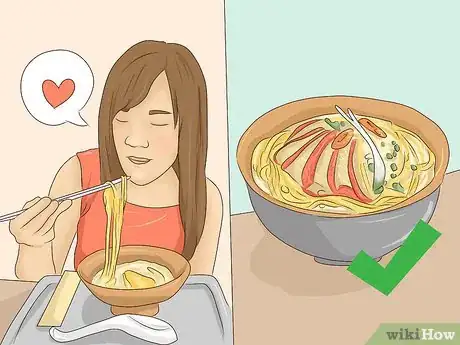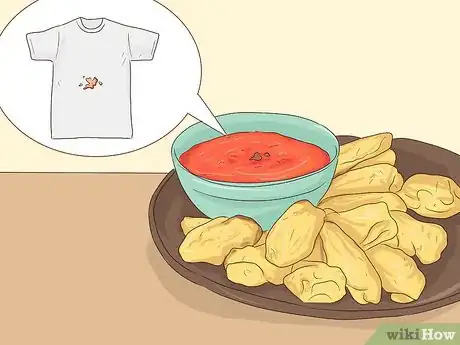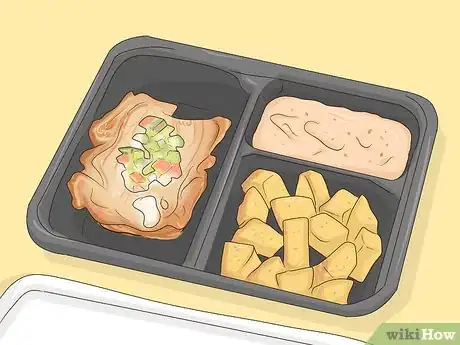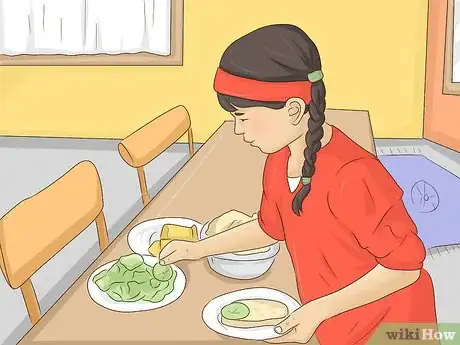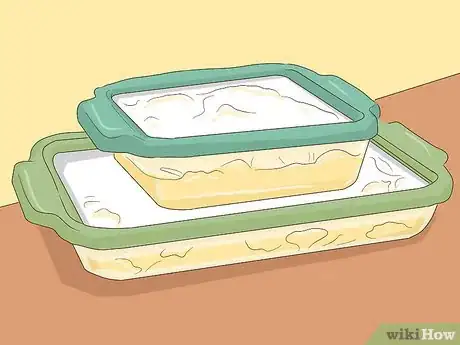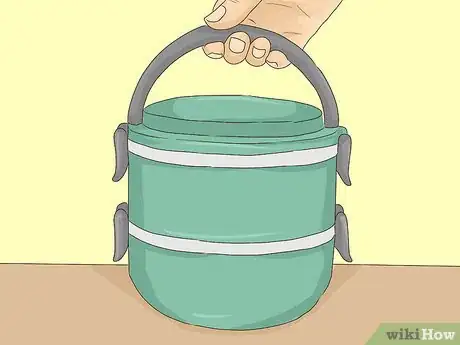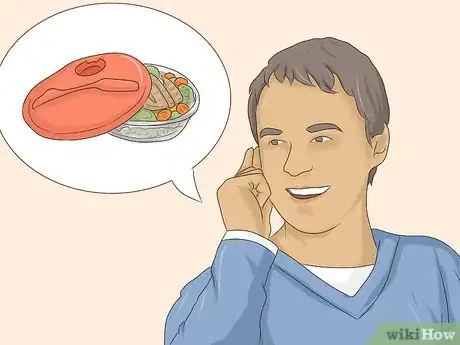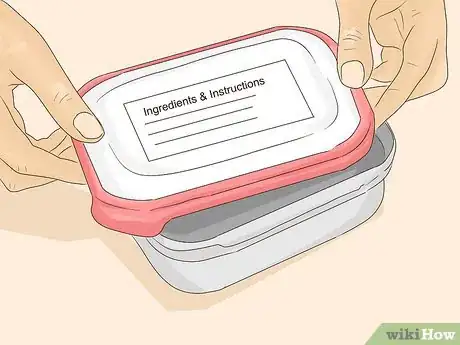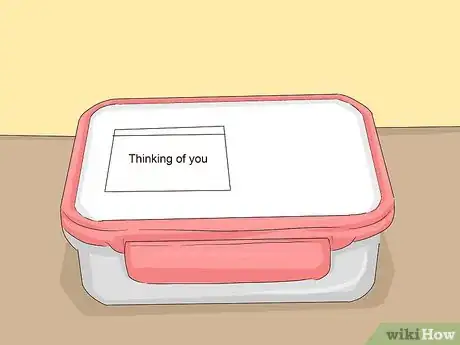This article was co-authored by wikiHow Staff. Our trained team of editors and researchers validate articles for accuracy and comprehensiveness. wikiHow's Content Management Team carefully monitors the work from our editorial staff to ensure that each article is backed by trusted research and meets our high quality standards.
This article has been viewed 12,336 times.
Bringing a friend food is a kind gesture, especially in a time of need. This might include when a friend has a new baby, is sick or injured, is going through bereavement, or needs help and support. Choose a meal that will appeal to your friend and to their family, noting any modifications or dietary restrictions they follow. Make it easy to transport and eat at a later time. When dropping off the meal, take some extra steps to make it easy, fast, and simple.
Steps
Choosing a Meal
-
1Bring a main meal. While cookies, muffins, and snacks are great housewarming gifts, people in need will benefit most from a main meal. This is especially true if children are a part of the family. Bring a main dish so that those eating will be full without needing another meal.[1]
- For example, bring a casserole, lasagna, or hearty soup.
-
2Choose a familiar recipe. Now might not be the time to experiment in the kitchen with a new recipe. Make something you know is delicious and that you've made before with positive feedback. Stick with a meal you know and are comfortable making. While you might want to make some changes or add some ingredients, don't make any drastic changes.[2]
- Choose something tried and tested that most people generally enjoy. For example, make lasagna, chili, or pizza.
-
3Be aware of food sensitivities. If your friend is a vegetarian, don't send them a meal with meat in it. Inquire about any food allergies or dietary restrictions before you begin preparing food. You may ask your friend or someone close to them if they have any food sensitivities or food restrictions.[3]
- Avoid common food allergens (like peanuts and shellfish) and other polarizing foods that people seem to either love or hate (like olives and fish).
- For example, don't bring anything spicy if you suspect they do not like spicy food.
-
4Pick something enjoyable. Your friend may love a certain type of cuisine, like noodles or spicy foods. Show your thoughtfulness by sending them their favorite foods. For example, if they love soup, make (or buy) soup you know they enjoy. If they have a taste for pizza, bring some by.
- Likewise, stay clear of foods they dislike or may not enjoy. For example, make warming foods on an especially cold night.
-
5Prepare something easy to eat. Don't bring a meal that's messy or difficult to eat or put together. For example, a DIY taco night might be fun, but it also might include lengthy setup or cleanup afterward. Keep your meals easy to eat and easy to clean up after.[4]
- Finger foods might be more difficult to keep clean up after, so aim to serve something that requires utensils.
- If serving food to children, keep it relatively mess-free. For example, if you include sauces, make sure they won't stain clothing.
Making Transport and Storage Simple
-
1Keep it easy to transport. Hold off on meals that require lots of pieces or separate items or dishes. Keep your meal simple and easy to move. As much as possible, keep everything self-contained or all together. Any assembly should be fairly simple and straightforward.[5]
- Keep delicate dishes for another time. If you care greatly how it looks or that it is presented a certain way, try something simpler or easier.
- For example, don't bring a liquid soup that can spill easily. If you do bring soup, make sure it is secured and unable to spill at any point during transport.
-
2Make it table ready. If you know your friend will be eating the meal once you bring it, drop it off hot and ready. Cook and prepare the meal ahead of time and if needed, heat it briefly when you drop it off at their house. Keep any work your friend or their family has to do minimal.[6]
- You might want to help get their table or eating area ready. Place utensils, glasses, and plates on the table to minimize meal preparation for your friend.
-
3Send a freezer meal. If you send something and your friend isn't prepared to eat it quite yet, make sure it's easy to stick in the freezer (or fridge) and eat another day reheated. Some examples of fridge or freezer meals might include casseroles, soups or stews, or ravioli.[7]
- Pack it into a container that's not too large or bulky. It should be able to be easily stacked or tucked away in a fridge or freezer.
-
4Donate the food containers. Don't ask for containers back if you can avoid it. Instead, prepare and pack your food in containers that your friend can keep and reuse. Clearly let the person know you don't need (or want) the containers back.[8]
- It can be stressful to sort out people's containers and who sent what, so keep it simple.
Dropping Off the Food
-
1Call ahead. Let the person know that food is on the way. Giving a heads up can ensure that someone will be there to accept the food and that they will be around to enjoy it. If you're a part of a train of people bringing meals, make sure you know when to drop it off and to whom.[9]
- The person may need to make room in the fridge or make other arrangements, so it's always best to give some warning.
-
2Include a list of ingredients and instructions. Even if you've checked with food sensitivities beforehand, it doesn't hurt to send a list of ingredients for anyone else who is enjoying the meal. Say how to reheat it (“Place it in the oven for 10 minutes at 200 degrees” or “Reheat in the microwave for 3 minutes”) and how to store it (in the fridge or freezer).[10]
- For example, attach a piece of paper with the ingredients and any other special instructions with the meal or tape it to the sides of the container.
-
3Add a personal note. Along with the meal, say something thoughtful or sweet in a note. This can show how much you care and support them. It might be a note of encouragement, something silly to make them laugh, or a thoughtful line to let them know they are in your thoughts. After the meal is gone, your kindness and thoughtfulness will be remembered.[11]
- Say something simple, such as “Thinking of you” or, “I hope you recover quickly.”
-
4Include some food staples. Along with your meal, include something that can be placed in the pantry or used over and over again. For example, include a jar of applesauce, box of crackers, or other staple items that can be snacked on or prepared easily.[12]
- For example, if you know your friend enjoys bagels, throw in a bag of bagels with your meal.
-
5Don't stay long. You may wish to stay and visit, but take any cues that your friend or their family want privacy. If you want to stay and talk, ask before you come over whether you can stay or whether you should schedule for another time. Your friend might be exhausted, so drop off your meal then be on your way.[13]
- Consider making time to talk when they are feeling good and not stressed.
References
- ↑ http://www.simplebites.net/cooking-for-others-a-guide-to-giving-sympathy-meals/
- ↑ http://www.takethemameal.com/blog/seven_steps.php
- ↑ http://www.simplebites.net/cooking-for-others-a-guide-to-giving-sympathy-meals/
- ↑ http://www.simplebites.net/cooking-for-others-a-guide-to-giving-sympathy-meals/
- ↑ http://www.thekitchn.com/10-of-my-favorite-meals-to-bring-to-a-friend-in-need-244269
- ↑ http://www.takethemameal.com/blog/seven_steps.php
- ↑ http://www.simplebites.net/cooking-for-others-a-guide-to-giving-sympathy-meals/
- ↑ http://www.simplebites.net/cooking-for-others-a-guide-to-giving-sympathy-meals/
- ↑ http://www.simplebites.net/cooking-for-others-a-guide-to-giving-sympathy-meals/



